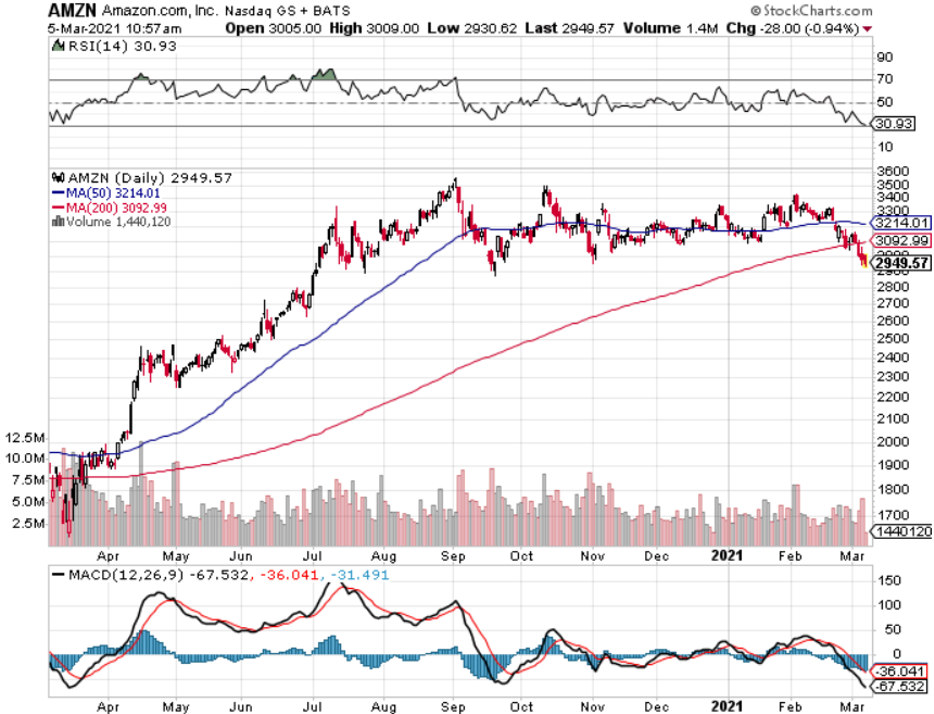When John identifies a strategic exit point, he will send you an alert with specific trade information as to what security to sell, when to sell it, and at what price. Most often, it will be to TAKE PROFITS, but, on rare occasions, it will be to exercise a STOP LOSS at a predetermined price to adhere to strict risk management discipline.


Tech Alert - Amazon.com, Inc. (AMZN) – STOP LOSS
SELL – STOP LOSS Amazon.com, Inc. (AMZN) March 2021 $2,940-$2,950 in-the-money vertical Bull call spread at $5.62
Closing Trade – NOT FOR NEW SUBSCRIBERS
3-5-2021
expiration date: March 19, 2021
Portfolio weighting: 10%
Number of Contracts = 11 contracts
This was a short-term bet that Amazon.com, Inc. (AMZN) would stay above $2,950 by the March expiration.
Big tech continues to get gouged, but I was able to execute an AMZN March $3,310-$3,315 put spread that will help soften the blow.
No doubt that tech is expensive and a retracement of this sort was in the card as Fed Governor Jerome Powell talks up higher inflation.
Higher inflation expectations erode tech growth and tech has endured a nasty risk-off move.
Long term, this is a great company, hold onto shares if you aren’t trading around.
What’s the reason to like Amazon?
The price action suggests that AMZN has a favorable chance to break up to the upside some point after what was a blowout fourth quarter results of net income of decisively more than the predicted $6.3 billion and revenue approaching $120 billion.
They outdid themselves and reported earnings of $14.09 per share on record revenue of $125.56 billion.
The e-commerce and technology titan went into its important holiday quarter report on a strong note and 2021 will be no different as features if the pandemic persists.
Just a quick rewind to the third quarter, revenue and earnings also easily beat consensus estimates, and Amazon perennially guides up. This is becoming a constant pattern with the stock boding well for the future stock price.
Investors like companies that constantly over-deliver on earnings metrics.
The biggest bombshell of late was clearly that Jeff Bezos, the company’s founder and CEO, would leave his role in the third quarter of 2021.
Next on deck is Andy Jassy, who currently leads Amazon Web Services (AWS), and will take over Bezos’ job.
Bezos will stick around in an “executive chairman” role and I envision this as Bezos not really leaving and still handling all the “big vision” stuff.
Inside the company, Jassy is the highest profile candidate and part of the most profitable part of the company giving him major clout.
This is out of the same mold of Microsoft’s CEO Satya Nadella who was also promoted to the top via the cloud division.
Bezos will now have more time to spend on Day 1 Fund which is a non-profit organization that will launch and operate a network of high-quality, full-scholarship Montessori-inspired preschools in underserved communities.
Along with that, he will spend time with the Bezos Earth Fund, Blue Origin, The Washington Post while Jassy handles the daily grind of the operation.
Don’t forget that Bezos is the largest shareholder, but because Amazon has become quite heralded for grooming top-level management, the company won’t miss a beat with Jassy.
If you don’t do options, hold the stock, my yearend target is $3,500.
Here are the specific trades you need to exit this position:
Sell to Close 11 March 20201 (AMZN) $2,940 calls at….………$89.75
Buy to Close 11 March 2021 (AMZN) $2,950 calls at........…….$84.13
Net Proceeds:……………………..…….….....................……..…….....$5.62
Loss: $8.65 - $5.62 = $3.03
(11 X 100 X $3.03) = $3,333 or 35.03%
If you are uncertain on how to execute an options spread, please watch my training video by clicking here.
The best execution can be had by placing your bid for the entire spread in the middle market and waiting for the market to come to you. The difference between the bid and the offer on these deep in-the-money spread trades can be enormous.
Don’t execute the legs individually or you will end up losing much of your profit. Spread pricing can be very volatile on expiration months farther out.
Keep in mind that these are ballpark prices at best. After the alerts go out, prices can be all over the map.



